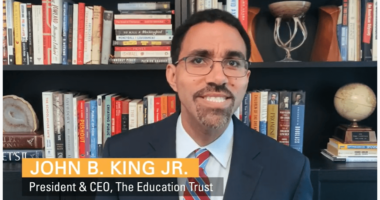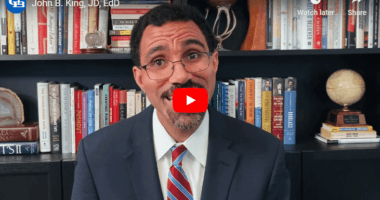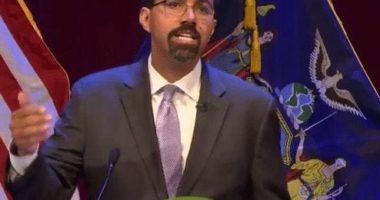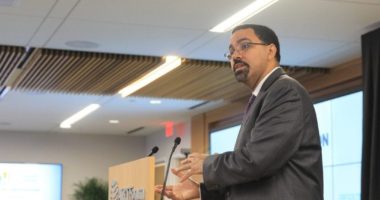The Transformative Power of Early Education to Close Opportunity and Achievement Gaps
On October 5, John B. King Jr. addressed the Zero to Three National Conference in Denver, Colorado, speaking about the importance of early childhood education and care.
Thank you, Myra, for the introduction, and to Paul, Matthew, and the entire ZERO TO THREE community for inviting me here to speak today. And congratulations to Bob Emde.
I want to begin by putting our conversation in some context—a context that compels us to think about opportunity and about equity, starting from when our children are born.
Consider, first, that not all mothers in this country have the same odds of making it through their pregnancy alive. In some places in America, Black women are as much as 12 times as likely to die from childbirth as White women are.
Consider that, nationally, the infant mortality rate for Black babies is more than twice as high as it is for White babies.
Consider a new report that shows, today, in 2018, a child who grows up poor in one city or town has much less of a chance of escaping poverty than similar children from low-income families living in a neighboring area.
Indeed, in far too many places, we have to ask, “Is opportunity better in the next state over, in the town across the river, or just down the block?” And in many cases, the answer is an emphatic “yes.”
Children raised in families struggling in poverty in some neighborhoods in Memphis, for example, grew up to earn just $16,000 a year in their adult households; while children from families of similar means living in some Minneapolis suburbs ended up earning four times as much.
How do these dynamics set up children—particularly children of color and children from low-income backgrounds—for success?
These are things that we must interrogate. That in 2018, the color of a child’s skin and the neighborhood in which she lives still determines so much of her destiny. Still.
Prenatal services, quality early childhood care, and great preschool programs are critical for shifting these dynamics … for, quite literally, changing the trajectory of lives.
Certainly, these services and programs are not an inoculation against poverty or a guarantee of future success, but they are an absolutely necessary part of providing children and families with ladders to opportunity, ladders to the American Dream.
I know it’s obvious to everyone in this room—thankfully—but I also want to ground our conversation today in this critical notion: the early years in a child’s life matter … a lot.
During the first few years, a child’s brain is developing rapidly. Young children are learning every second.
In fact, the name of our host organization, “Zero to Three,” is compelling precisely because children’s brains are growing the quickest between the ages of zero to three.
I have two daughters, and I remember the first few years of their lives and being completely overwhelmed at how quickly they were learning, noticing the world around them, and growing in their ability to communicate their thoughts, feelings, and needs.
Playing and learning happen together when children are young—and great early childhood educators are absolutely essential to creating the opportunities and the environment for children’s learning and development to occur … particularly for students of color and students from low-income backgrounds who need the most support.
So I want to be sure today to thank all of the early childhood educators and leaders here in the room for what you do each day. It is invaluable work.
Each of us in this room knows that even as infants, children are learning and developing skills that will help to determine their future.
We know that children as young as seven months old old are already learning to produce language.
And we know that children who face adversity at a young age, or who experience trauma or significant stress are more likely to develop delays in their cognitive, language, and emotional development.
That’s why services and supports through high-quality early learning and care are crucial for building a strong foundation for children—especially the most vulnerable—from day one.
Without access to high-quality early learning opportunities, historically underserved children, including children of color and children from low-income backgrounds—are more likely to enter kindergarten behind their peers—both socioemotionally and academically.
I recently visited a school in rural Delaware and spoke with two kindergarten teachers. When I asked them, “If you were given an additional $1 million from the state to invest in anything at your school, what would it be?”
Both of them immediately responded that they would invest the additional resources in quality early childhood education programs in the community.
They said every year they have students in class who come in reading, and working on their writing. And every year, they have students who haven’t had access to early learning opportunities and who don’t recognize the difference between letters and numbers.
According to a recent study, when a child enters kindergarten ready for school, there is an 82 percent chance that child will master basic skills by age 11, compared with a 45 percent chance for children who are not ready for school.
Another study found that attending a high-quality preschool reduced the percentage of children repeating a grade by 15 percent.
Years of evidence also make clear the long-term benefits of early childhood education, both for individuals and for our society.
Several studies have shown that investing in early childhood education, especially for disadvantaged children, is an effective strategy for reducing social costs later in life – such as poor health, dropout rates, poverty, and crime.
In fact, a recent study of the Perry Preschool program shows a 7-10 percent per year return on investment based on increased achievement in school and careers, as well as reduced costs in remedial education, health, and criminal justice system expenditures.
For high-quality, birth-to-five programs for disadvantaged children, the return on investment is even higher, at 13 percent.
We can see similar results for children who attended the Chicago Child-Parent Centers as preschoolers in the early 1980s.
On average, children who attended the program completed more years of education than those who didn’t. The effects became even more apparent the longer children stayed in the program.
And for children who stayed in the program through preschool, nearly 16 percent received an associate’s degree or higher, compared to about 11 percent of children who didn’t.
Shocking to no one here, kids’ lives don’t begin at age five.
And for far too many children who face the greatest challenges, reaching them only once they enter kindergarten can mean that these children have an even steeper mountain to climb in order to be prepared to succeed in school.
We cannot afford to deny children, especially children from low-income backgrounds, children of color, and our dual-language learners, access to high-quality early learning and care.
You’ll notice that one of the key words I just said is “quality.” We’re here today to talk about equity in early childhood education, closing both opportunity and achievement gaps. I believe that educational equity is educational justice for our babies who are underserved. And I believe that the quality of the learning opportunities that children receive is a key component of educational equity.
If we’re working toward equity, it’s not enough simply to expand the number of early childhood education programs. That’s because access to a low-quality program is no access at all.
In fact, it’s a false promise—and a missed opportunity for policymakers, program administrators, families, children, and whole communities.
The truth is, affluent families have much greater choices in terms of where they send their children to receive early learning and care.
To truly reduce inequity and expand opportunity, we have to make sure we’re providing children of color and children from low-income families with excellent early childhood options.
No child’s socioeconomic background should determine her opportunities.
But infants and toddlers are the most likely to live in poverty compared to people of any other age group in the U.S. In fact, nearly half of America’s babies live at or near poverty.
No child’s zip code should determine her opportunities.
But data show that early childhood poverty rates vary widely in states—from 11 percent in New Hampshire to 33 percent in West Virginia.
And no child’s race or background should determine her opportunities.
But an analysis from Zero to Three shows that Hispanic and Black babies are disproportionately affected by poverty—2 and 3 times more than White babies, respectively.
All of this matters because research shows that poverty can negatively impact brain development in key areas for our babies—from self-regulation and learning to emotional control to language and memory.
In addition to the effects of poverty, we know that access to high-quality early childhood education is not distributed evenly across the country.
Here in Colorado, for example, only 42 percent of 3- and 4-year-olds from low-income families are enrolled in early childhood education, compared to 56 percent of 3- and 4-year-olds from higher income families.
Nationally, low-income children and Black children are the least likely to have access to high-quality programs.
A recent NIEER study found that only a quarter of Black children were in center-based care that was rated as high quality.
Additionally, NCES data shows that children from families making less than $20,000 a year are the least likely to be enrolled in high-quality early childhood programs, nationally.
Clearly, there is an urgent need for the work in which everyone in this room is engaged.
Even as we continue to work with a sense of urgency, I think it’s important to acknowledge the progress that early childhood leaders, parents and families, and whole communities have made together in expanding access to quality early learning and care in recent years.
Because of strong early childhood programs, rigorous research, and persistent advocacy, in 2017, 89 percent of voters in the United States, across bipartisan lines, supported making quality early education for children from birth through age five, including child care, more affordable for working families.
This enthusiasm and support has translated directly into policy change to expand access and increase quality of early childhood learning and care.
In 2017, state lawmakers across the country addressed an array of policy issues related to our youngest learners. The National Conference of State Legislatures found, for example, nearly 140 bills in 33 states were signed into law in 2017.
Policymakers addressed issues related to the quality of and access to childcare, home visiting and parent education programs, preschool and kindergarten readiness, and exclusionary discipline in early childhood programs.
Nationally, over the past decade, we’ve also made significant investments at the federal level.
The Maternal, Infant, and Early Childhood Home Visiting program provides federal funding for voluntary home visiting services. The program has bipartisan support in Congress and states, and was recently reauthorized for an additional five years.
The federal program also spurred ten states to develop their own additional state-level program for home visiting.
What’s more, we’ve seen reinvestment in Head Start and Early Head Start, and new investments in early learning in the Every Student Succeeds Act, and through federal Preschool Development Grants – aimed at improving coordination, quality, and access to early childhood programming and care for children ages birth through five.
Amid this progress, we must also acknowledge that we have further to go.
Families do not have robust access to the high-quality health services and early learning programs that can set them up for long-term success.
Far too many expectant mothers in the U.S., for example, received delayed or no prenatal care in 2014. And 10 percent of babies were born pre-term.
While investments in public preschool for 3- and 4-year olds is up across the country, and more children are taking advantage of these programs, enrollment remains far too low. Only 40 percent of 3-year-olds across the country are enrolled in any early childhood program, far below the OECD average of 70 percent.
We also know that six in ten 4-year-olds in America are not enrolled in publicly funded preschool programs. More than 2.5 million 4-year olds, in fact, do not have access to publicly funded preschool.
And it’s a well-known fact that the cost of childcare is still much too high in this country.
While the Department of Health and Human Services considers affordable childcare as no more than 10 percent of a family’s income, the average cost of childcare in every state in the U.S. requires families to spend more than that.
In Washington, D.C., for instance, families spend, on average, more than one quarter of their annual income on childcare.
And despite the fact that the federal government provides funding to some low-income families to subsidize the cost of childcare through the Child Care and Development Fund, the program only serves 1 in 10 eligible children.
Finally, access to affordable center- and home-based care remains out of reach for many families with infants and toddlers, too.
In fact, in a recent study of 22 states by the Center for American Progress, more than half of the population live in “child care deserts,” meaning they live in neighborhoods or communities with little or no access to quality child care.
We are all here today because we understand that the progress we have made thus far in expanding access to high-quality early childhood education and care is not enough. We are here today because we are all committed to changing systems that are failing too many kids.
And as you go back to your daily work after this convening, I urge you to think about what it will take to create a system of early learning and care that sets every child – especially children from low-income families and children of color – on the path to true educational equity … to ensure that they receive educational justice.
Today, I’d like to suggest six “to do’s” for everyone in the room.
First – and you know this part well – in order to achieve true equity and justice for all children, we must begin caring before birth and into infancy.
Equity in early childhood begins with proper prenatal care, parental education, and evidence-based home visiting programs.
Evidence-based home visiting programs help children and families get off to a healthy, strong start.
These programs, which often focus on first-time, single mothers, provide nurse home visits during the prenatal period and early in a child’s infancy to help mothers make good decisions about their home environment and to learn parenting skills.
Evidence shows the programs lead to better health for the mother and child, as well as improvements in the child’s later cognitive and academic outcomes.
In 2017, all 50 states, plus DC, have programs in place to implement evidence-based home visiting programs.
In South Carolina, the Positive Parenting Program provides a suite of interventions, including parenting seminars, counseling, and parent skills training to families of young children.
Through this approach, parents learn how to manage their children’s behavior in a healthy way, which has led to reductions in child abuse and neglect and fewer foster care placements for children with parents receiving services.
The program also has resulted in decreases in parent depression, stress, and emotional distress.
But heartbreakingly, while federal funding through the Maternal, Infant, and Early Childhood Home Visiting Program (MIECHV) is significant – it reaches just a fraction of the families in need of services.
Nationwide, more than 18 million families have a child under 6 years old, or a baby on the way. Yet only 3 percent of these families received services from any evidence-based home visiting program in 2017 (according to the National Home Visiting Resource Center).
What’s more troubling is that more than half of the approximately 18 million families (52 percent) are considered high-priority, meaning that there is an infant under one-year old in the family, the family’s income is below the poverty line, the family is headed by a teenaged or single mother, or the parents have never completed high school.
Home visiting programs could have significant benefits for every child, but they are especially impactful for these families and children, as well as for first-time parents, parents experiencing poverty, parents and families whose primary language is not English, and parents struggling with addiction. This is especially important as we see our nation facing a crisis of opioid addiction.
States can, and should, be thinking about how to leverage the Every Student Succeeds Act, or ESSA – through Title I dollars or Preschool Development Grants – or early Head Start to add to these funds and expand services.
Some communities are finding ways to supplement those funds by making additional investments, and developing public-private partnerships with local organizations.
In Durham, North Carolina, for example, Durham Connects – a partnership among healthcare providers, community agencies, and families – was established to provide EVERY parent of a newborn with two free, in-home nurse visits.
Registered nurses provide health checks for the mother and newborn, and they can support families in finding additional resources in the community – such as financial assistance or parenting classes.
And this leads me to the second “to-do.” We cannot achieve educational equity and justice for all our children until we find ways to better coordinate among service providers, education programs, and policymakers.
This is especially important with our youngest children. If children are experiencing hunger, homelessness, health problems, or have a parent struggling with mental health issues or substance abuse, that directly impacts both their immediate and long-term health, well-being, and educational outcomes.
The work that you all do each day cuts across sectors by necessity. There are social workers working with pediatricians working with developmental psychologists working with speech pathologists working with educators working with childcare providers working with children.
In this way, it’s critical to provide a continuum of care for children and families. And to do that, we must further break down silos. We must make space for collaboration, and shared resources and information among home and health programs, social work, and education.
New York’s First 1,000 Days on Medicaid Initiative is an example of a state moving toward this type of collaboration.
Through the Initiative, the state is aiming to improve coordination among health, home, and education services for Medicaid recipients during the first 1,000 days, or roughly 3 years, of a child’s life.
Only by working together will we be able to best identify families and children who need services and deliver the most comprehensive supports.
This entails coordinating systems, including healthcare for families through Medicaid expansion and paid family leave so that babies can develop secure attachment with their parents and families. Our international competitors do this. This also entails mental health services, particularly helping parents and families to manage stresses.
I truly believe that the definition of educational equity … the definition of educational justice … is created by an entire community of adults and systems working together to support the success of ALL children and families.
The third “to-do”, as I alluded to earlier, is that we must focus on quality as a key component of expanding educational equity. Every child deserves access to high-quality early learning and care.
And one important factor contributing to quality is the expectations that we have for children. For all children.
When I was commissioner of education in New York, I once took a tour of a high school.
I asked the principal, “What’s the graduation rate here?” She said, “Well … you know … a lot of kids are from the public housing project across the street.” And I said, “Yes; but what’s the graduation rate?” For her, the answer to the question was: “Do you know where these kids are from?”
As educators, advocates, service providers, policymakers, and community leaders we have a responsibility to say that can’t be the answer to the question. That can’t be right.
We can’t assume—because our kids are living in poverty, because they speak Spanish at home, because one of their parents is incarcerated—that they can’t succeed.
The same is true in our early childhood centers and preschools. Every child deserves our very highest expectations for what they can achieve, from the very earliest years in their lives.
Unfortunately, in 2017, only a handful of states met all ten of NIEER’s benchmarks for quality standards, and nine states met less than half of the standards.
Another factor contributing to quality is the relationship between early childhood providers and educators and the children they serve. Indeed, as we have learned from pioneering work from researchers, including UVA ed school dean Robert Pianta, the interactions between children and teachers are the very essence of quality education programs.
Dean Pianta has created the CLASS observation tool for improving teacher-child interactions, which encourages key questions, such as: Are the teachers warm and nurturing? Do educators ask questions in such a way that children are able to build their understanding and use language to express themselves? How do educators deal with behavioral challenges? Are the choices educators make helpful or harsh?
I’ve heard it said that relationships are the curricula of early childhood care and education. And they don’t just happen on their own. They don’t just happen at circle time, alone, they happen by creating loving and engaging environments, and when adults provide children with the support to explore.
This work is personal for me. I know that great teachers, at any age, can be life changing.
I grew up in Brooklyn in New York City. My mother passed away when I was eight in October of my fourth grade year. Afterward, I lived with my father who was very sick with undiagnosed Alzheimer’s disease. From one night to the next, I didn’t know what home was going to be like. It was unpredictable and, sometimes, even scary.
My life, at that point, could have gone in many different directions. But I am here today because I had amazing teachers in my public schools – teachers, who, quite literally saved my life.
In my teachers’ classrooms, we put on productions of A Midsummer Night’s Dream and Alice in Wonderland. We visited museums, the ballet, and the botanical gardens. We read books, and The New York Times every day.
My teachers could have looked at me and said, “Here is a young African-American, Latino boy with a family in crisis. What chance does he have?” But, instead, they chose to invest in me. And they gave me hope.
My teachers made school a place that was engaging, supportive, and safe. And the investment that my teachers made in me saved my life.
And there are great early childhood educators making those same investments in our youngest learners every day – and those educators are saving kids’ lives.
Recruiting and retaining strong, diverse early childhood educators is key to high-quality programs for children.
However, the systems we have in place to prepare, support, and pay early childhood educators do not match our understanding of their importance to our children.
Currently, qualifications for preschool programs vary widely – for instance, 34 of 60 public programs across the U.S. require lead preschool teachers to have a bachelor’s degree.
Early childhood educators need specific training and ongoing support to be successful in their role. But as qualifications for the early learning workforce increase, we must also invest in current early childhood educators.
This means working with practitioners already in centers and classrooms to provide the support and training needed to meet new or changing standards.
This also means compensating early childhood workers at comparable levels to their elementary school counterparts.
While I was at the Department of Education, the Obama administration released a report that showed the average salary for preschool teachers ($28,570) was roughly half of the salary earned by elementary school teachers ($54,890).
In all states, an early childcare educator supporting a family of three would have qualified in 2016 for SNAP benefits.
If we are not investing in educators for our youngest learners, what does that say about how much we value our children?
And investments have to include salary, benefits, and opportunities for continuous learning.
While we’re talking about quality, we also need to address the challenges we currently face in both identifying and tracking quality.
Quality Rating and Improvement Systems, or QRIS, are critically important for states to be able to assess the quality of early learning and care programs, and for parents to be able to identify and compare the quality of programs.
QRIS have to be well designed—they have to center the importance of socioemotional learning and the power of play and exploration, which are backed up by research on brain science.
However, participation in QRIS is often voluntary, and low. In 2016, only three states – Illinois, New Hampshire, and Oklahoma – had QRIS that included information on 100 percent of eligible early childhood providers.
Many systems provide bonuses or higher reimbursement rates for programs that achieve higher levels of quality along a spectrum of standards – including staff qualifications and training, curriculum, family partnerships, health and safety. Others provide targeted technical assistance for programs that service high-needs communities and low-income children.
QRIS ultimately provides a framework for early childhood providers that allows states, communities, and families to make better decisions for children.
One of the major challenges with QRIS and tracking outcomes in early learning, however, is data access and quality.
Because of the voluntary nature of QRIS, and the mixed delivery models in early childhood education, we don’t often know where children are being served before kindergarten.
Part of QRIS and state oversight can and should be connecting data from our preschools through the K-12 system.
The fourth “to-do” for everyone in the room is to focus on, and champion, diversity.
We’ve spoken a lot in recent years about the importance of diversity in the K-12 space, but less so about its critical importance in early childhood programs.
However, when we look at enrollment data in early childhood programs, we find similar trends of segregation by socioeconomic status and by race and ethnicity as we see in the public K-12 system, especially for students in public preschool programs.
In New York City, for example, we see that preschool classrooms are, on average, more racially and ethnically segregated than public kindergarten classrooms.
For example, in one in six pre-k classrooms in New York City, more than 90 percent of students belonged to the same racial or ethnic group – compared to one in eight kindergarten classrooms.
Research clearly shows that diversity matters in education.
A recent study examined two groups of low-income children, one attending preschools with high concentrations of poverty, and the other attending socioeconomically diverse preschools. Researchers found that by the spring of preschool, the children attending the economically mixed programs learned more language skills than children in programs serving a predominately homogenous mix of children from low-income families.
Today, diversity isn’t just a nicety. It’s a real contributor to better outcomes in our schools, workplaces, and communities.
When our children have diverse friends, that helps to curb racism.
All children should have the opportunity to learn alongside diverse peers, and to learn from diverse educators.
And diversity matters, now more than ever, especially because we know that our country is becoming increasingly diverse. The majority of children under five are children of color.
Increasing diversity means that early childhood practitioners must be able to work across cultures, languages, and family structures to best serve kids. This isn’t always easy work, and requires intentionality.
This work requires both recruiting educators from the community that you serve, and recruiting culturally and linguistically diverse educators. We also know that the early childhood educator workforce is made up predominantly of women and that we need more men in early childhood classrooms.
A focus on diversity also requires providing resources and supports to educators – in the form of practical, concrete professional development opportunities – as well as time for your educators to engage in reflection and deep learning.
Collaboration time can help educators to better support students who are struggling with building relationships in their classrooms or students who are struggling at nap time.
Let’s be clear. We know there are consequences when this work is not done. And to illustrate this point, I’d like to encourage everyone in this room to take a quick look at discipline with me:
A study by the Center for American Progress found that while across the country Black children represent 18 percent of preschool enrollment, they represent 48 percent of preschool children – babies – receiving more than one out-of-school suspension.
Many of you also may be familiar with a recent Yale Child Study Center analysis. Researchers found that preschool teachers who were asked to watch video clips of children and to be on the lookout for behavior problems, were more likely to focus on the Black boys in the videos than other children…even though none of the children in the videos were actually behaving badly.
And that’s the thing that all of us have to check: our expectations of children and our biases show through. We must be conscious of them and confront them, for the good of our kids.
One of the growing early childhood populations across the country are our Dual Language Learners.
I think it’s critically important that early childhood practitioners recognize being bilingual as an asset, rather than a barrier to learning.
Research has shown that bilingual children are often better communicators, have a stronger attention span, and can become even stronger readers – in both languages – than their peers. But too often, we aren’t providing the support, resources and opportunities needed for dual language learners to thrive.
According to a NIEER report from earlier this year, nearly a quarter of American 3- and 4-year olds speak a language other than English at home, so this is a very important issue for our early childhood leaders to tackle.
One important way to start supporting Dual Language Learners is to ensure that practitioners and educators are linguistically diverse, and are able to communicate in a child’s home language.
It’s also important to provide opportunities for professional learning for staff and educators on how to instruct children who don’t speak English fluently, and cultural competency training on interacting with families who speak another language.
We have to support families around the importance of talking with their child and reading with them in their home language.
Montgomery County, Maryland, where I live and where my daughters currently attend school, is doing a lot of work to better support Dual Language Learners and to ensure that they are receiving high-quality, culturally appropriate childcare and early learning opportunities.
Montgomery County is a diverse community. Many home care providers in the area are recent immigrants, providing services to the growing immigrant community. The County is working directly with these home care providers to support and improve the quality of these programs.
Maryland has strict licensing requirements for family and home-based early childhood providers, and Montgomery County is working with family care providers to support them through the licensing and accreditation process, and to ensure they are in the state’s Quality, Rating, and Improvement System.
In recent years, we’ve also seen an uptick in dual language immersion programs in both preschool and the K-12 space. Many of these programs have demonstrated results for dual language learners, students from low-income backgrounds, and students of color.
However, we need to be mindful that when we offer these programs, the kids who are from households who speak the foreign language at home should be at least a significant portion of the kids who are enrolled.
Many higher income and White parents recognize the benefits of being bilingual, and what we have seen is that, in some cases, the seats in dual language immersion programs are filled by higher-income, White children.
But in building programs, we must be intentional and ensure that those programs are reaching the students who can benefit from the services the most.
The fifth item on our collective to-do list is to better support children through the transition between early childhood education and care, and kindergarten.
In too many cases, the transition for a child between early childhood centers and kindergarten is jarring. Kids thrive on predictability, and adapting to a new environment can be extremely stressful.
Research shows that thoughtful processes that engage parents, teachers, and young students in moving between programs can improve children’s success in school.
When children enter kindergarten and find routines and experiences that build upon their experiences in early learning, they are more likely to feel comfortable and engaged.
A study out of Duke University found that planned transitions with parent involvement were especially important for students from low-income families.
For example, sending information about the new school and classroom home to families early and often, providing opportunities for families to visit the school and the new classroom ahead of the start of the kindergarten school year, hosting a parent orientation, and sending teachers into the community for home visits with families all had positive effects on academic achievement outcomes.
And while many early childhood programs are separate from the K-12 systems that the children they serve will attend, collaboration between these two systems, as I mentioned earlier, is key.
The more that you, as leaders of early childhood centers and programs, can work with local kindergarten providers to align content and routines, and share data and information, the better chances our youngest learners will have to succeed beyond your care.
And, finally, as we wrap up our discussion about equity and justice … as we remember to (1) begin care from birth, (2) find ways to break down silos, (3) focus on quality, (4) champion diversity, and (5) better support children through the transition to kindergarten, there’s just one more thing that I’d like to encourage all of us to do. And that is to ensure that in our equity work, we also make sure that all our children have equitable access to joy and wonder in their learning.
I’ve been fortunate to visit many early childhood centers and preschool programs. My daughters benefited from early childhood education and care and Montessori experiences. And, like everyone in this room here knows, part of what distinguishes great programs is that the joy of the center, the joy and wonder of the classroom, is palpable.
You can see it in the child who is playing—and learning—at the water table … gleefully splashing around, while examining which toys sink or float.
You can see it in the child who is at the role-play center, trying on different outfits and imagining herself as a doctor or chef someday.
You can see it in the child who is painting at the easel, amazed that mixing his blue paint and red paint together makes an entirely new and beautiful color.
And you can see it in the children sitting in “song circle,” learning how to make music together with instruments and their voices.
We need to invest to make this possible for all kids.
I want to close today by acknowledging that this work—to expand equity and to ensure all our children are cared for, learning, and loved, requires a lot of you.
And I want to share an example of something that struck me about a recent trip to Texas.
I was in Austin for a conference on social emotional learning and I spoke about the efforts that Tacoma, Washington is leading.
Tacoma has a districtwide focus on social emotional learning that is interconnected with rigorous academics. When students are learning something and get stuck, that’s when the students engage in something their educators call “emotional labor.”
Emotional labor. That’s the act of persevering through tough challenges, believing a positive outcome is possible, and supporting your peers as they work alongside you until the ultimate goal is achieved.
I think the idea of emotional labor is truly powerful. It requires an acknowledgement that the work is hard. It requires a hopeful outlook. And it requires teamwork.
Certainly the efforts in which all of us are engaged require emotional labor. And our hearts can get heavy when we see yet another example of how far we have to go – a family experiencing homelessness with young children … babies ripped from their parents’ arms at the border, inflicting indescribable trauma … a parent who is struggling with substance abuse or mental health issues … inequities in opportunity that deny students of color and low-income students their right to quality early learning and care.
But if we have a hopeful outlook, and acknowledge progress even with the recognition that the work isn’t done, and if we realize that we aren’t alone in this effort… then I believe we can succeed in leading with equity in mind.
The other thing that emotional labor requires of us is self-care.
In order to provide a safe, nurturing, warm environment for children to learn and grow, we, ourselves, have to take time to reflect, to nurture ourselves, and to lift up our colleagues when they need it. In order to be good for the work, we have to be good to ourselves.
The work you do every day has never been more important.
It is on us to give our children the skills and knowledge they need to go out into the world and thrive.
Thank you for your advocacy and everything you do every day to make that possible for kids. I am honored to be in the fight for equity alongside you.










